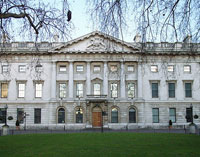 The Royal Mint of the United Kingdom is the only place allowed to print coins throughout the United Kingdom. The Mint has been in operation for more than 1,100 years.
The Royal Mint of the United Kingdom is the only place allowed to print coins throughout the United Kingdom. The Mint has been in operation for more than 1,100 years.
In 1279, the Mint was moved to the Tower of London, where it remained until the 16th century. During this time, it came to be the only mint operating in England.It originally began operating under Alfred the Great in 886. At the time, there were several mints located throughout the British kingdom.
Production was gradually shifted to the new site until all operations were located in South Wales in 1980. This is also the home of an impressive coin collection that dates to the 16th century.
Eighty cabinets designed by Hugh Swann, cabinet maker to Elizabeth II, are used to hold and showcase the collection.
The United Kingdom uses a Trial of the Pyx procedure to ensure that all coins meet the pre-determined standards. These trials date back to the twelfth century, and continue to be an important part of operations.
A jury consisting of Freeman of the Company of Goldsmiths will then examine the coins to determine if they meet the proper standards as set by the relevant Coinage Acts.
A source of income as well as a source of currency, the Royal Mint also mints coins for other countries, as well as producing medals and commemorative coins. It is currently the largest exporting Mint in the world.
The Mint produces coins for circulation, as well as Sovereign coins and Britannia coins in gold and silver. They also offer presentation sets, many of which would make impressive gifts for special occasions.
Medals, commemorative coins and stamp and coin sets are all produced at the Royal Mint. It is certain that they will continue to be produced at this historic and trusted Mint for generations still to come.
If you buy, or already own gold coins or bars, and plan to keep them at home, be sure to read our page on storing your gold.

